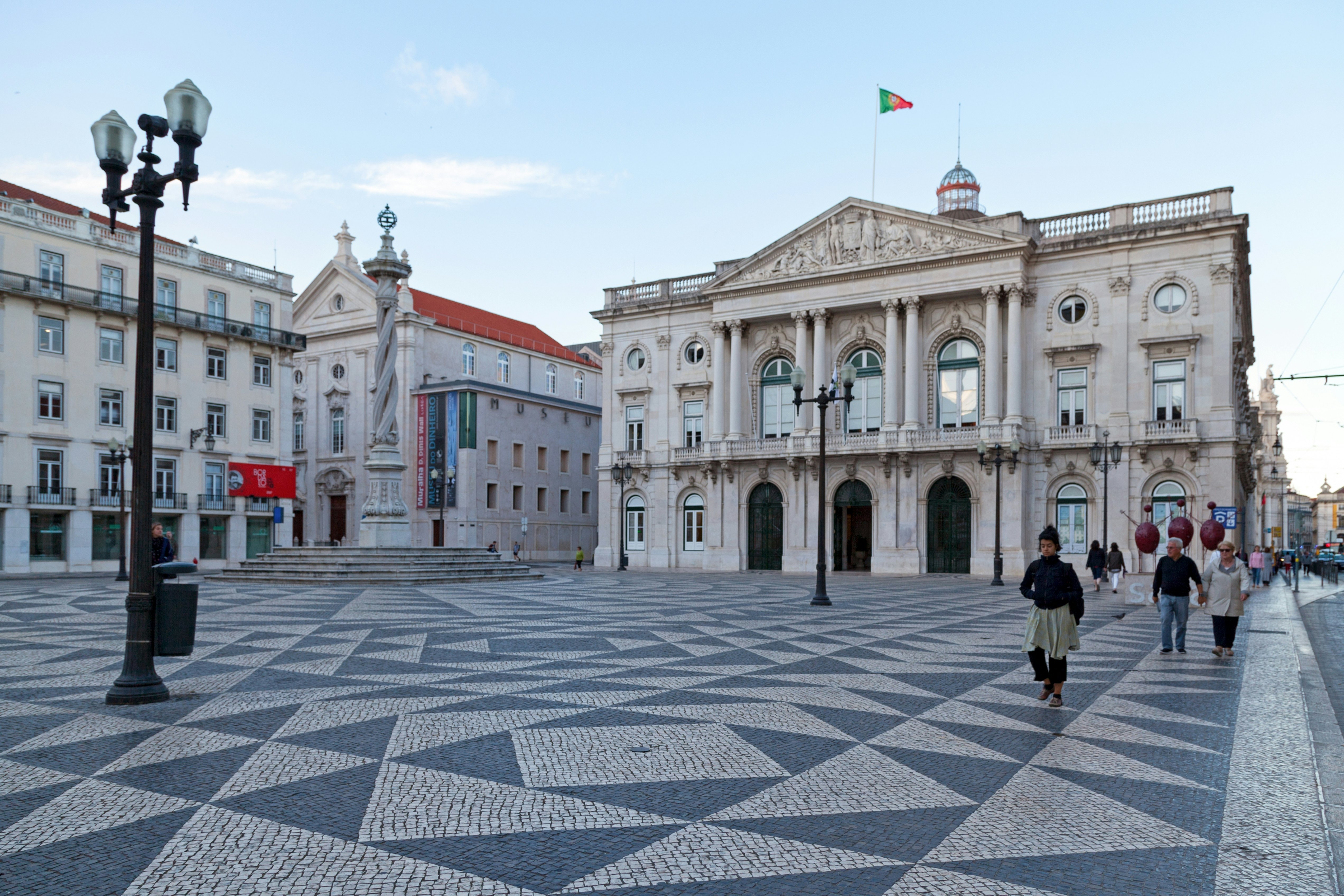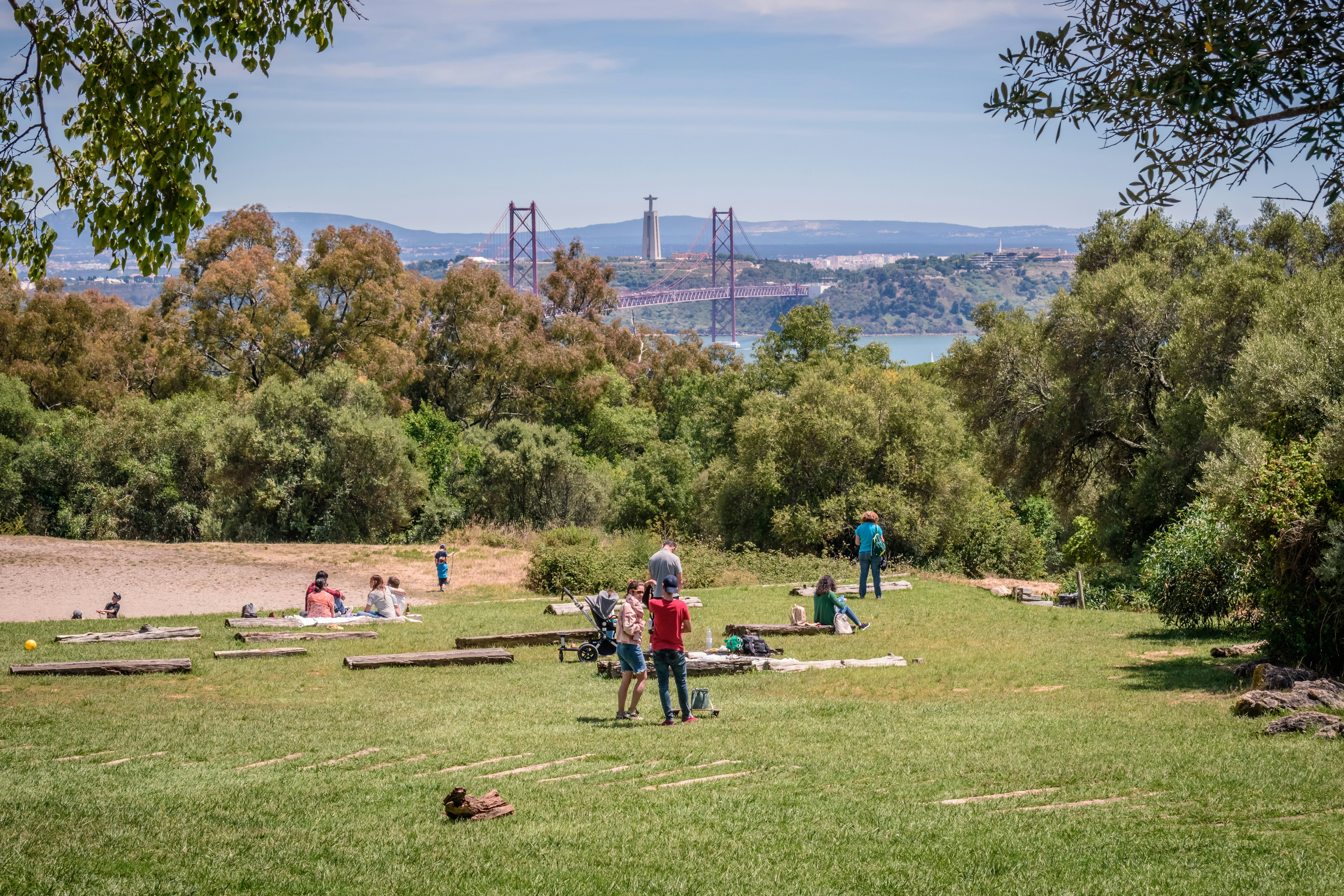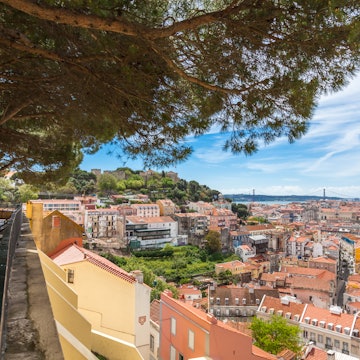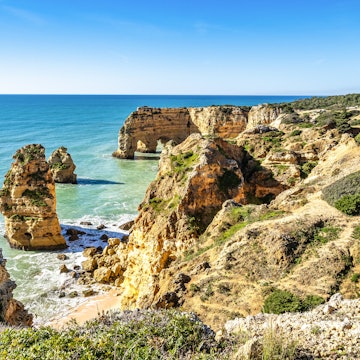

Views over Lisbon from Miradouro de Santa Luzia. cktravels.com/Shutterstock
It's easy to enjoy Lisbon without breaking the bank because the Portuguese capital's biggest draws are outdoors, from astounding views at hilltop miradouros (lookouts) to tranquil squares and magical strolls in historic neighborhoods. Many hostels also offer free walking tours that guide you through street art displays and historical sites. Here are the best things you can do in Lisbon for free.
1. Gaze over Lisbon's rooftops from Miradouro de Santa Luzia
Lisbon has some spectacular viewpoints, but Miradouro de Santa Luzia scores high in romantic points. Admire the blue-and-white glazed tile panel on the church wall that depicts Praça do Comércio before the Great Earthquake in 1755. Head to the terrace for sweeping views of terracotta rooftops, the white dome of the Panteão Nacional and the semi-industrial skyline of the Tagus River’s south bank.
Local tip: Buy a cocktail to accompany the incredible view. Farther up the street, Portas do Sol offers stunning city views and refreshing drinks that you can order at the onsite cafe with outdoor seating.

2. Hold a gold bar in Museu do Dinheiro
The nine rooms of Lisbon’s Money Museum tell the story of currency and commercial transactions over the years. Educational and fun, the museum offers the chance to hold and touch an authentic gold bar, which is a favorite with kids. In addition to displays of money, museum-goers get to see another treasure: the remains of the 700-year-old medieval wall that once protected the city.
3. Visit Igreja de Santo António
Although Lisbon officially has two patron saints, Vicente and António, the latter is by far the most popular and the most celebrated. The small baroque-rococo style church of Santo António was built close to the house where he was born in 1195. Because Santo António is also known as the matchmaker saint, devout newlyweds visit the church on their wedding day to pray, ask for protection and donate flowers.

4. Wander the historical streets of Alfama...
Stow away your Lisbon map and get lost in the winding streets of the city’s oldest neighborhood, Alfama. In this medieval maze of alleyways, stairs, fountains and interior courtyards, you’ll come across the postcard-perfect image of tile facades and hanging laundry.
A dramatic sequence of events took place in the city on November 1, 1755, when an earthquake, followed by a fire and a tsunami, left little of Lisbon standing. Keep your eyes peeled for the oldest house in Lisbon, on Rua dos Cegos, and Igreja da Conceição Velha – built in the same Manueline style as Mosteiro dos Jerónimos in Belém –that both survived the quake. Seeing this example of Manueline architecture, particularly its ornate portal, in this part of Lisbon is a treat.
5. ...and then visit Madragoa
Hop on tram 28E to get across town and explore the other must-see historical neighborhood of Lisbon, Madragoa. It’s not as well-known as Alfama, but it’s one of the Lisbon greats, with a balanced mix of businesses catering to locals and visitors.

6. Tour the architecture and enjoy the view from Cemitério dos Prazeres
The grand gate, tall cypresses and wide lanes of Cemitério dos Prazeres contradict whatever eerie image you might have of a cemetery. A magnificent example of late 19th-century funeral architecture in the Campo de Ourique neighborhood, Prazeres is the final resting place of several distinguished Portuguese figures, from artists and writers to politicians. Head down to the Artists’ Plot, on the left-hand side, for a full view of Ponte 25 de Abril.
7. Take a free tour of ancient Lisbon
Rebuilding Lisbon after the earthquake was so urgent that you can hardly see what the city was like before. In the early 1990s, during the renovation of a bank’s headquarters at Rua dos Correeiros, builders hit an archaeological jackpot of 2500 years of Lisbon history. A pre-booked free guided tour of Núcleo Arqueológico da Rua dos Correeiros will take you through each historical layer, from the Roman period to the late 1700s.
Planning tip: This is a popular attraction with both tourists and locals alike – school groups often snap up the tour places. Be sure to book your visit in advance to avoid disappointment.

8. Escape the summer heat in Jardins da Gulbenkian
A haven of much-needed shade in hot summers and sun-drenched glades in the winters, the Modernist gardens of Fundação Calouste Gulbenkian are a local favorite. Share space with wobbling resident ducks on their way to the pond, or take your reading to the open-air amphitheater.
9. Cool off near the Caminho da Água
Caminho da Água is an art installation by Rigo in Alameda dos Oceanos, one of the main lanes of Parque das Nações area. Cartoon characters and ocean motifs decorate the calçada Portuguesa (Portuguese pavement) path, where six colorful, tile-covered water volcanoes “erupt” at regular intervals for kids to splash around in.

10. Stroll past incredible architecture in Parque das Nações
The former grounds of Expo 1998, Parque das Nações on the city's east side is now an urban park where you can admire contemporary architecture. From Santiago Calatrava’s Gare do Oriente to Álvaro Siza Vieira’s Pavilhão de Portugal, the park is a top attraction for architecture enthusiasts. There are plenty of riverside gardens and walkways to admire the Tagus and Europe’s second-longest bridge, Ponte Vasco da Gama.
11. Watch the sunset near Cais das Colunas
Once the main gateway to Lisbon for visitors arriving by ship, Cais das Colunas is now a magnet for sunset watchers, serenaded with the occasional amateur live music show. Sit on the marble steps to soak up the sun or watch it set over Ponte 25 de Abril.

12. People watch in Praça do Martim Moniz
At the heart of Mouraria, Praça do Martim Moniz is a locals' favorite for people-watching and winding down on late afternoons. It often goes unnoticed, but across the street from this square, you can see the remains of Lisbon's medieval wall. What can't be missed, though, is the Castelo de São Jorge on top, overlooking the city from the highest of the seven hills.
13. Admire the outdoor artwork of the Galeria de Arte Urbana
Brave the steep climb uphill on Calçada da Glória to visit Lisbon’s urban art gallery. The designated spot of Galeria de Arte Urbana has seven panels for pre-approved projects by up-and-coming or established street artists. After admiring the latest pieces, get ready to snap one of Lisbon’s most iconic mustard-yellow lifts: Ascensor da Glória. The lift becomes a canvas for graffiti art itself quite often.

14. Take a hike in Parque Florestal de Monsanto
Known as Lisbon’s lung, Parque Florestal de Monsanto is the city’s largest urban park, almost three times bigger than New York City's Central Park. Organized into several areas, Monsanto has designated picnic and barbecue areas, smaller parks for children, and plenty of hiking and cycling trails. Once you’re done exploring the park, you can walk or cycle back to the city center on the 2.4km (1.5-mile) Corredor Verde pathway.
15. Marvel at the intricate beauty of Igreja de São Roque
This 16th-century church near Bairro Alto is one of the few buildings in Lisbon to have survived the 1755 earthquake's massive destruction. Behind the stern-looking facade, there's an intricately decorated interior of frescoes and gilded carved wood, with nine chapels, each designed and adorned according to the taste and style of those who commissioned the work.
Planning tip: It costs €8 (US$9.20) to visit the adjacent museum.

16. Browse the market at Feira da Ladra
A trip to Feira da Ladra, the longest-running flea market in Lisbon, is a mix of bargain hunting and people-watching. Anything and everything is sold here every Tuesday and Saturday, and you never know what treasures you might find on an old sheet stretched out on the pavement.
17. Stumble across ancient Roman ruins
After the earthquake of 1755, most of Lisbon was rebuilt in record time without paying much attention to what lay below. But now, accidentally unearthing traces of ancient Rome during new building construction is common in contemporary Lisbon. When that happens, construction comes to a halt, and the city's team of archaeologists takes over to properly catalog the artifacts. When building resumes, it's often around the newly found remains.
That's the case with Casa dos Bicos, which houses Fundação José Saramago and the Eurostars Museum. In both buildings’ lobbies, ancient Roman remains and traces from other historical periods can be visited for free. In Alfama, up the street from Sé de Lisboa, take a peek at the ongoing open-air excavation of the first-century Roman theater just outside the Museu do Teatro Romano.

18. Learn about traditional Portuguese art forms
Amália Rodrigues was Portugal’s most famous Fado singer and an ambassador of this urban music genre all over the world. Vhils, Portugal's most famous urban artist abroad, immortalized Rodrigues in the heart of Alfama with the help of professional paving stone layers, building a black and white portrait of Rodrigues in typical Portuguese pavement known as calçada Portuguesa. Stop by Rua dos Cegos 42 to see three sides of Lisbon’s urban culture coming together in one piece.
19. Escape the urban buzz in Jardim da Estrela
The gated, English-inspired Jardim da Estrela is considered one of Lisbon’s most romantic gardens, primarily because of its beautiful style but also for its quiet scenery of leafy trees, ponds, kiosks turned cafes and the wrought-iron bandstand used for occasional live music performances in the summer.

20. See the mixed architectural styles of the Sé de Lisboa
Like most 12th-century medieval churches in the country, Sé de Lisboa, Lisbon's cathedral, was built on top of an old mosque after the first king of Portugal, Afonso Henriques, took the city from the North African Muslims. Over the centuries, reconstructions and renovations have added Gothic and baroque details to the original Romanesque structure.
Planning tip: Admire the exterior for free, or pay €7 (US$8) to go inside.
21. Learn more about Lisbon's bloody history at Igreja de São Domingos
Once the home of the Portuguese Inquisition and the venue of choice for royal weddings, Igreja de São Domingos has survived two major earthquakes and one raging fire. Unlike other Catholic churches in Lisbon, most of São Domingos' walls are bare, and signs of destruction are still visible from the 1959 fire, which destroyed most of its interior and works of religious art.

22. Discover a secret viewpoint in Parque Eduardo VII
The mid-century-style manicured Parque Eduardo VII is the largest park in the center of Lisbon and the chosen location for many of the city's outdoor events, including the Lisbon Book Fair (Feira do Livro de Lisboa) in the spring. On the north side of the park, next to João Cutileiro’s monument in honor of the 25th of April Carnation Revolution, is one of Lisbon’s lesser-known viewpoints from where you can see part of the Baixa neighborhood, the Tagus River and the south bank.
23. Enjoy free concerts at Museu do Fado
If you’re curious about fado, the iconic traditional Portuguese melancholic musical genre, but want to skip the bustle of a traditional restaurant with live performances, check Museu do Fado’s website for upcoming free concerts. A bit of the luck of the draw, these performances range from established, classic fadistas (Fado singers) to newcomers and fusion-style reinterpretations of Portugal’s urban song. Tickets must be booked in advance.
















